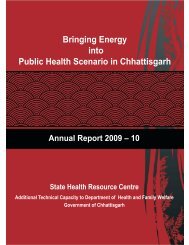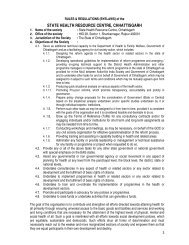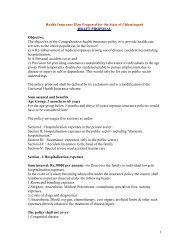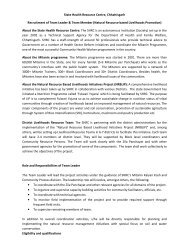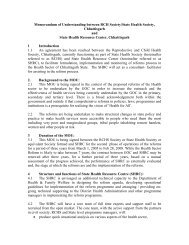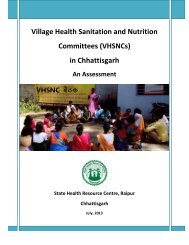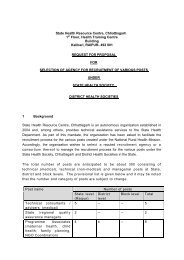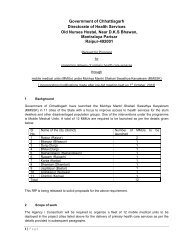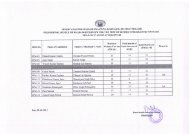PRESCRIPTION ANALYSIS REPORT State Health Resource Centre ...
PRESCRIPTION ANALYSIS REPORT State Health Resource Centre ...
PRESCRIPTION ANALYSIS REPORT State Health Resource Centre ...
- No tags were found...
Create successful ePaper yourself
Turn your PDF publications into a flip-book with our unique Google optimized e-Paper software.
<strong>PRESCRIPTION</strong> <strong>ANALYSIS</strong> <strong>REPORT</strong><strong>State</strong> <strong>Health</strong> <strong>Resource</strong> <strong>Centre</strong> is a pioneer institute in designing Drafting & makingchanges in state policy & health care services in Chhattisgarh SHRC has given akaleidoscopic vision and improvement regarding health in Chhattisgarh.SHRC had assigned a small task of Prescription Analysis of Prescribes in C.G.Initially the work assigned was designing and framing the format of the prescription ofDhamtari District. After few meeting & discussion with Dr. Sundara Raman, seven moredistricts were included in the analysis. There were 312 prescriptions comprising of eightdistricts.1. Jagdalpur 282. Dhamtari 633. Rajnandgaon 404. Bhilai 135. Care ( Raipur) 356. Raigarh 627. Dhamtari 358. Mahasamund 36Total 312A retrospective study was conducted for a period of five months of all the collected312 Prescription, which was obtained from SHRC written by Govt. & Private Practitioners.The study was done to1. Asses the prescribing pattern of the Doctors2. Evaluate the prescriptions for their rational approach.All 312 prescriptions were analyzed. The prescription in which duration was notmentioned calculation was done for one day requirement. All the price calculation was doneexcluding sale tax. Combined drugs with brand name have been counted as a single drug.Following team of faculties conducted the work.1. Dr. Manju Toppo, Asstt. Prof. Department of Community Medicine2. Dr. Nirmal Verma, Asstt. Prof. Department of Community Medicine& Assisted byDr. Teeku Sinha, P.G. in Community MedicineDr. Subhra Agrawal, P.G. in Community Medicine
Table No.- 1Format AdequacyFormat Adequacy Yes No. TotalName 297 (95.19%) 15 (4.81%) 312Age 246 (78.85%) 66 (21.15%) 312Sex 178 (57.05%) 134 (42.95%) 312Diagnosis - 33 (10.58%)Complete 158 (50.64%)Incomplete 11 (3.52%)Symptoms 110 (35.26%)Above Table describes about the adequacy of format. Out of 312 Prescriptions, Name of thepatient was written in maximum of prescription i.e. 297 (95%) followed by Age & Sex i.e.246 (78%) & 178 (57%) Regarding Diagnosis Almost half the prescriptions had completediagnosis written i.e. 158 (50.64%) followed by symptom writing i.e. 110 (35.26%). Around33 (10.58%) of the prescriptions had no diagnosis/symptom written & about 11 (3.52%)prescriptions had incomplete diagnosis written.
Table No. – 2Type of Prescribed DrugsType of drugs No. % of drugsGeneric Name 485 43.00%Brand Name 563 49.91%Illegible 80 7.09%Total Drugs 1128 100%Average No. of Drugs / Prescription = 3.62 / Prescriptions.Average No. of Generic Drugs / Prescription = 1.55/ Prescriptions.Average No. Brand / Prescription = 1.80/ Prescriptions.No. of Prescriptions with only Generic = 75 (24.04%).No. of Prescriptions with only Brand = 68 (21.80%).No. of Prescriptions with Brand & Generic = 166 (53.21%).(Note :- Three Pts. referred with out prescription of any drug)Above table shows the prescription pattern of drugs out of 1128 drugs prescribedbrand drugs occupied a majority of 563 (49.19%) followed by Generic drugs i.e. 483(43.00%) & Illegible was 80 (7.09%) .Average no. of drugs per prescription was found to be 3.62/ Prescriptions followedby Average no. of brand drugs / prescription which was 1.80/ prescriptions & Average no.of Generic drug was only 1.55/ Prescriptions no. of prescription comprising of Generic &Brand which formed a majority of 166 (53.21%) & no. of Prescription with only Genericwas 75 (24.04%) & no. of Prescription with only brand name was 68 (21.80%).
DrugsTable No. – 3Pattern of Prescription of Antibiotics & AnalgesicsPrescribedNo.Average noPrescriptionTotal costAverage cost/ DrugAverage costfor Drug /PrescriptionAntibiotics 220 0.71 7884.27 35.83 25.27Analgesics 176 0.56 1699.99 9.65 5.45Above table shows the Pattern of Prescription of antibiotics & Analgesics. TotalPrescribed Antibiotics were 220 that contribute 0.71/ prescription & the total cost of theseantibiotics was Rs. 7884.27. Average cost / antibiotic was Rs. 35.83 & average expense onthese antibiotics/ Prescription was Rs. 25.27.Similarly, total prescribed analgesics were 176 (including some FDC) thatcontribute 0.56/ prescriptions. The total costs of these analgesics are Rs. 1699.99.Average cost / analgesic was Rs. 09.65 & average expense on these analgesics /Prescription was Rs.05.45.
Table No. - 4Comparative Table of Prescribed Drugs & Their CostType of Drugs No % Total Cost No. ofdrugs/PrescriptionAverage costRs. Of Drugs/PrescriptionsEssential Drugs 622 55.14% 15106.28/- 1.99 48.41/-Irrational Drugs 426 37.77% 10680.24/- 1.37 34.23/-Illegible 80 7.09% - 0.26 -Total 1128 100% 25786.3/-(excluding 80drugs illegible)CheaperAlternative ofEssential DrugsTotal Possiblesavings if RDTfollowed3.62 82.64/- (excl.illegible.drugs)- - 8619.9/- - 27.62/-- - 17167.27- - 55.02/-Above table highlights & compares the prescribed drugs & their cost. Out of 1128drugs prescribed a majority of drugs were essential i.e. 622 (55.14%) followed by irrationaldrugs i.e. 426 (37.77%) & illegible amounting to a small number of 80 (7.09%).The total cost incurred in essential drugs was Rs.15106.28where as irrational Drugsamounted to about Rs. 10680.24.Average 1.99 drugs / prescription were found essential drugs while 1.37 drugs /prescription were irrational. Average cost of drugs/ Prescription amounted to be Rs 82.64/-.Out of which Rs. 48.41 per prescription was spent for essential drugs and Rs. 34.23 perprescription for irrational drugs. Whereas Cheaper Alternative of Essential drugs was Rs.8619.19/- costing to Average cost of Drug/ Prescription i.e. Rs. 27.62. The most remarkablefinding was the total possible saving if RDT followed amounted to about 17167.27. Thus,Rs. 55.02 per prescription could be saved if drugs were prescribed as per RDT guidelines.
Table No. – 5Pattern of Use of Irrational DrugsDrugs No./ Prescribed %Antibiotics 77 18.08%Analgesics 32 07.51%Banned drugs 40 09.39Tonic 04 00.94%Cough formula 32 07.51%Multivitamins 60 14.09%Vit. B.C. 49 11.50%Ayurvedic Drugs 10 02.35%OFD Combination 15 03.21%Others 107 25.12%Total 426 100%Above table highlights the pattern of use of irrational drugs. Out of total 423 excessive drugsmajority of them were multivitamins & Vitamin B. Complex 109 (25.59%) followed by othergroup comprising of antacids, antiallergic etc.107 (25.12%), antibiotics 77 (18.08%) banneddrugs 40 (09.39%), Analgesics & cough formula 32 (7.51% each group), OFD combination15 (3.21%), Ayurvedic drugs 10 (2.35%) and least were tonics 04 (0.94%).
No of Drugs inprescriptionsTable No. – 6NO.OF DRUGS PER <strong>PRESCRIPTION</strong>Only Generic Only Brand Both Generic &Brand (mixed)Total1-2 24 (7.69%) 30 (9.62% 14 (4.49%) 68 (21.80%)3-5 51 (16.35%) 37 (11.86%) 123 (39.425) 211 (67.63%)>5 00 01 (0.32%) 29 (9.30%) 30 (9.62%)Total 75 68 166 309(Note: - three Pts referred with out prescription any drugs)Above table shows the no. & type of Drugs prescribed in all prescriptions. In a total 309Prescription 75 were only Generic in which maximum prescription had 3-5 Generic drug i.e.51 (16.35%) Brand drugs were 68 in number in which maximum prescription had 3-5 Branddrug i.e. 37 (11.86%) Mixed drugs amounted to 166 in which maximum prescriptions had 3-5 mixed drug i.e. 123 (39.42%) followed by prescription more than 5 drugs i.e. 29 (9.30%).
Table No. –7Dose & Duration InadequacyVariants No of Prescription % of PrescriptionsBoth Dose & DurationInadequacy83 26.60%Only Duration inadequacy 52 16.67%Only Dose inadequacy 06 01.92%Total 141 45.10%Above total signifies the dose & durations inadequacy of drugs prescribed. Out of 312prescriptions, 141 (45.19%) were such prescription, which had inadequacy. Out of 312prescriptions 83 (26.60%) prescriptions had both dose & duration inadequacy, which was ingreat majority. Duration inadequacy also formed a large no of 52 (16.67%). Only Doseinadequacy was 06 (01.92%) respectively.
Table No. – 8Injection Practices of PrescriptionsInjection Total % of PrescriptionsNecessary Injection 44 14.10 %Unnecessary Injection OfNecessary Drugs51 16.35 %Irrational Inj. 71 22.76 %Total Prescription 312Above table shows the injection practices amongst prescribers. Out of total 312prescription, Irrational Injection were in majority i.e. 71 (22.76 %) followed by use ofUnnecessary injection of Necessary Drugs i.e. 51 (16.35 %) Necessary injection practice was44 ( 14.10 %) only.
CONCLUSION1. Evaluation for format adequacy patient identity & out of 312 prescriptions Majorityof the prescriptions had Name, Age & Sex written i.e. (95.19%), 78.85% & 57.05 %and 50.64% had complete diagnosis written.2. Type of Drug: - Generic name usage is only 43 % & Brand name usage is 49.91% &illegible drugs were 07.09%.3. Majority of the prescriptions consisted of both generic & brand drugs (53.21 %).4. A majority of the drugs prescribed was Essential i.e. 55.14%, Costing to Rs. 48.41where cheaper alternative amounted to Rs. 27.62. Thus, the possible saving if RDTfollowed would have been Rs. 55.02 per prescription.5. The major irrational use drugs were multivitamins & B-complex (25.59 %).6. Dose & Duration inadequacy was found in 45.19 % of prescriptions.7. Cost of Antibiotics & Analgesics was Rs. 35.23/- & Rs. 09.65/- respectively, andaverage expense on these antibiotics per prescription & analgesic per prescriptionwas Rs. 25.27/- & Rs. 5.45/-.Necessary Injection Practice amongst prescriptions was only 14.10 % of prescription,Irrational& Unnecessary injections of necessary Injection use was 39.10 % of prescription
RECOMMENDATIONSThe findings obtained after auditing the prescriptions indicates that majority of theprescriptions do adhere to the ideal pattern of the prescription writing. Over prescription &mixed prescriptions of Generic & Brand was found prevalent indicating the increasingtendency of polypharmacy. This tendency is due to the patient expectations & demand ofquick relief .Incorrect diagnosis & excessive use of antibiotics may be mainly due to influence of thelucrative, promotional programme of different drug companies to attract as many as doctorsas possible to increase their sale.More than 45% prescriptions were dose & duration inadequate which shows that prescribersneed updating regarding prescription writing.Using cheaper alternatives, which are equally effective & equally good, can minimize the costof essential drugs prescribed. Govt. of Chhattisgarh should make a policy & training forpractitioner at regular intervals for rational use of drug. These help the nation & society in along way to help a sick person by saving his pocket as much as possible.




